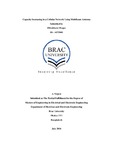| dc.contributor.advisor | Ahmed, Dr. Tarem | |
| dc.contributor.advisor | Kazi, Sadia | |
| dc.contributor.advisor | Huq, Rachaen | |
| dc.contributor.author | Hoque, Ifthakharul | |
| dc.date.accessioned | 2016-09-24T07:11:32Z | |
| dc.date.available | 2016-09-24T07:11:32Z | |
| dc.date.copyright | 2016 | |
| dc.date.issued | 2016-07 | |
| dc.identifier.other | ID 14373001 | |
| dc.identifier.uri | http://hdl.handle.net/10361/6444 | |
| dc.description | This thesis report is submitted in partial fulfillment of the requirements for the degree of Bachelor of Science in Electrical and Electronic Engineering, 2016. | en_US |
| dc.description | Cataloged from PDF version of thesis report. | |
| dc.description | Includes bibliographical references (page 41). | |
| dc.description.abstract | Today’s mobile subscribers have a voracious appetite for data. As smartphones flood the wireless market, the demand for higher data throughput continues to skyrocket. As a result, operators are searching for simple, cost-effective ways to add capacity. Timely roll out of new 3G and 4G services is key to addressing subscriber needs and protecting their reputation for efficiency and reliability. When operators need to add capacity, they typically build new cell sites or split sectors by adding more antennas to existing sites. However, both options are time-consuming and expensive. To build new cell sites, the expense, time and effort required to deploy a new site is significant. Deployment costs and regulatory approvals can easily delay the installation of new sites for up to 2 years. Given these challenges, operators understand that this option is no longer realistic. Add more equipment to existing sites is also expensive and complex. The conversion process overlays new technology onto older infrastructure, requiring a complete radio frequency path to the base station for each new sector. You may also need filters, tower-mounted amplifiers or multi-band combiners, which can cause compatibility issues and pile on the expenses. Zoning challenges, leasing fees and extra wind load can add even more complexity to the process. Multi-beam antennas can give double, triple even nine times more capacity compare to existing without adding more antennas on site. | en_US |
| dc.description.statementofresponsibility | Ifthakharul Hoque | |
| dc.language.iso | en | en_US |
| dc.publisher | BRAC University | en_US |
| dc.rights | BRAC University thesis are protected by copyright. They may be viewed from this source for any purpose, but reproduction or distribution in any format is prohibited without written permission. | |
| dc.subject | Cellular network | en_US |
| dc.subject | Multibeam antenna | en_US |
| dc.title | Capacity increasing of a cellular network using multibeam antenna | en_US |
| dc.type | Thesis | en_US |
| dc.contributor.department | Department of Electrical and Electronic Engineering, BRAC University | |
| dc.description.degree | B. Electrical and Electronic Engineering | |
| dc.eprint.version | 41 pages | |

